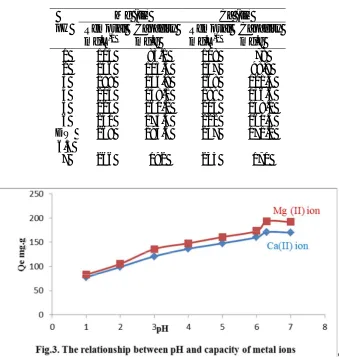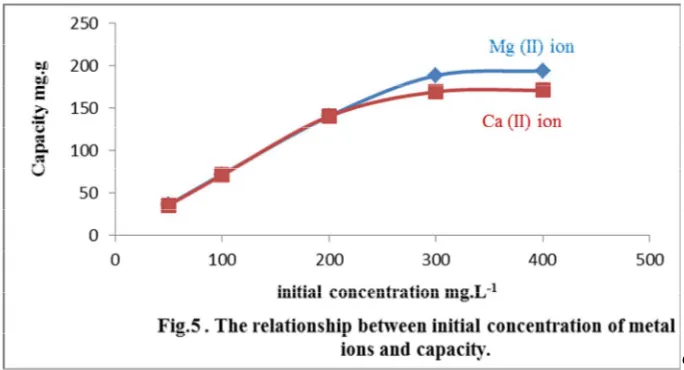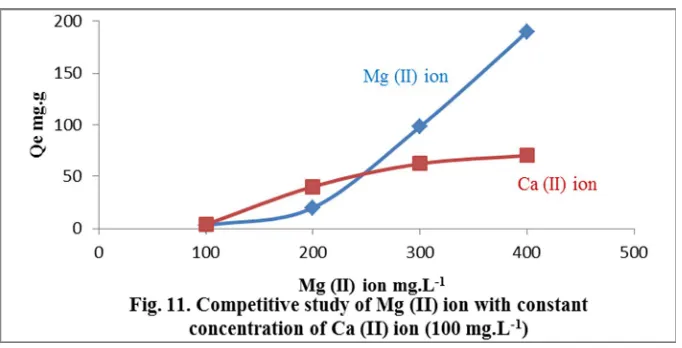Corresponding Author E-mail: mohammedlord2003@yahoo.com 1142 | Page
International journal of Advanced Biological and Biomedical Research
Volume 1, Issue 9, 2013: 1142-1156
New approach for removal of total hardness ( Ca
2+, Mg
2+) from water using
commercial polyacrylic acid hydrogel beads, study and application
Ahmed Mahdi Saeed* and Mohammad Jassim Hamzah**
* Department of chemistry, College of science, University of Wasit, Iraq
**Department of pharmaceutical chemistry, College of pharmacy, University of Kerbala, Iraq
ABSTRACT
Adsorption and water treatment of Ca (II) and Mg (II) hardness were investigated via adsorption of metal ions onto commercial polyacrylic acid hydrogel beads as a novel sorbent for metal ions (Ca2+, Mg2+) removal and water treatment. Batch equilibrium technique was carried out under the influence of solution pH, contact time, sorbent dosage, initial metal concentration and competitive study. The maximum metal ions capacity (Ca2+, Mg2+) values were identified as 171.2 and 193.6, respectively. Sorption equilibrium was established in 24 hr and the data were described by both Langmuir and Freundlich models. The potential application of this sorbent for water treatment and metal ions removal from water samples is successfully accomplished.
Key word: Removal, Polyacrylic acid, Hydrogel bead, New approach
1-INTRODUCTION
1143 | Page
[17]. The two major methods which are typically used to remove hardness form water are lime soda softening and ion exchange softening. The first method is used mostly for municipal purposes [18]. The primary drawbacks of the lime soda method include the production of a large volume of sludge that requires post-treatment, excessive use of chemicals (such as lime soda ash, and caustic soda) and the addition of acids for pH adjustment, which increases operating expenses [19]. The ion exchange process is primarily employed for residential water softening. Experimental studies have found the sodium level in softened water was 2.5 time higher than municipal water [20]. Adsorption is one of the few promising alternatives for this purpose, especially using low-cost sorbets. A three-dimensional super absorption polymers were used as a absorbents for heavy metal ions from water and other aqueous solution susficialy. Polymer like polyacrylic acid, polyacryliamide and its derivatives which have functional groups (such as carboxylic, hydroxyl and amide) can be used as absorbents for metal ions removal via the interaction between the metal ions and these groups [21].
2-Material and Instrumentations
2.1-Instrumentations:
Atomic absorption spectrophotometer (AAS) type (Phoenix-986 AN, England) was used to determine Mg (II) and Ca (II) ions concentration. An Ametrohm E. 632 pH meter (Switzerland), fitted with an Ametrohm combined glass electrode was calibrated according to conventional methods and used to adjust the pH of the solution in each experiment. Sartorius BL 210 S (Germany), max. 210 g, D 0.1 mg, was used for chemicals and gel beads weighing. A Vernier caliper with 0.01 mm measuring accuracy was used for measurement of the diameter of the gel beads.
2.2-Chemicals and solutions:
A commercial poly acrylic acid (PAA) hydrogel beads have (3.56 mm diameter and 0.0346 g weight) were used in this work. All other chemicals used throughout this study were of analytical reagent grade and were purchased from Aldrich Chemical Company. A 1000 mg / L aqueous solution of Mg (II) and Ca (II) ions were prepared from magnesium sulphate heptahydrate and calcium chloride salts. More dilute solutions of metal ions were prepared from stock solutions by simple dilution with distilled water.
3-Adsorption studies
3.1Effect of contact time on metal ions removal:
The previously mentioned batch experiment procedure was carried out at different contact time of 2,4,8,12,24 and 48 hr. The adsorption experiments were conduct at a pH of 6.3 at room temperature (25 ±
2 ˚C) and solutions concentration of 400 mg.L-1. The residual metal ions concentration after adsorption
process was determined by AAS and the metal ions adsorption capacities at each time value were evaluated using the following equation:[22]
Q = (Co – Ce) V / m ……1
Where Q is the amount of metal ions adsorbed at time t or at equilibrium (mg / g) that represented the amount of metal ions mg adsorbed per gram of dry gel bead. Co, Ce are the initial and final concentration
1144 | Page
3.2-Effect of pH on metal ions removal:
All batch experiments were carried out at room temperature and each experiment was performed in 25 ml volumetric flask using 25 ml of 400 mg.L-1 metal ions solution and one hydrogel bead has (0.0346 g) weight. The pH of solution was adjusted at a range of (1- 7) and left for 24 hr contact time. Residual metal ions concentration was determined by AAS and the adsorption capacity was evaluated from equation (1).
3.3-Effect of adsorbent dosage on metal ions removal:
Similar batch experiment were carried out by mixing 25 ml of 1000 mg.L-1 metal ions solution with different number of hydrogel bead 1,2,3,4,5 and 6 have (0.0346, 0.0692, 0.1038, 0.1384, 0.173 and 0.2076 g) weight. The solutions were adjusted at pH of 6.3 and lifted for 24 hr at room temperature. The residual metal ions concentration was determined using AAS and the percentages of metal ions removal and adsorption capacity were then evaluated.
3.4-Effect of initial metal ions concentration on adsorption capacity:
Adsorption equilibrium and isotherm studies were evaluated by varying the initial metal ions concentration. A 25 ml solution of 50, 100, 200, 300 and 400 mg.L-1 metal ions was used at pH of 6.3. The solutions were left at room temperature for 24 hr and the residual metal ions concentration was determined using AAS.
3.5-Competitive adsorption study:
Competitive adsorption of Mg (II) and Ca (II) ions by the PAA hydrogel bead from aqueous solution containing the two ions together was investigated in these two groups of experiment as listed in Table 1. The adsorption experiments were carried out at pH of 6.3 at room temperature and 24 hr contact time. The adsorption capacities of hydrogel bead were evaluated using equation 1 and the following equation for selectivity percentage (SP):[23]
1145 | Page
Table. 1. The mixture of metal ions in competitive study.
Experiment 1 Experiment 2
Metal ion Concentration mg.L-1
Metal ion Concentration mg.L-1
Mg / Ca Ca / Mg
100/100 100/100
200/100 200/100
300/100 300/100
400/100 400/100
4-Results and discussion
All the results obtained are tabulated in Tables 2- 10. 4.1-Effect of contact time:
Adsorption capacities remained and removal metal ions (Table 2) of Mg (II) and Ca (II) as function of contact time are shown in Fig. 1 and 2. The adsorption of both two ions in PAA hydrogel beads was identified to proceed via two successive steps. In the initial step, the removal efficiencies of both Mg (II) and Ca (II) increased rapidly due to the abundant availability of active binding sites on sorbent surface. With the gradual occupancy of these sites, the adsorption process becomes less efficient due to a complete saturation of the surface with metal ions in a later step. One of the vital advantages of this sorbent is the large adsorption capacity (i.e. 1 Kg of Mg (II) ion in water need about 0.179 Kg of gel bead for its removal).
Table. 2. Summary of the result obtained from the contact time study. Time
hr.
Mg (II) ion Ca (II)
Remained mg.L-1 Removal mg.L-1 Capacity mg.g Remained mg.L-1 Removal mg.L-1 Capacity mg.g
2 315 85 61.4 357 43 31.1
4 240 160 115.6 288 112 80.9
8 187 213 153.9 215 185 132.2
12 158 242 174.9 183 217 156.8
24 132 268 193.6 163 237 171.2
1146 | Page
4.2-Effect of pH:
1147 | Page
Table. 3. The results obtained from the effect of pH study.
pH
Mg (II) Ca (II)
Removal mg.L-1
Capacity mg.g
Removal mg.L-1
Capacity mg.g
1 115 83.1 108 78
2 146 105.5 137 98.9
3 188 135.8 168 121.4
4 205 148.1 189 136.6
5 223 161.1 205 148.1
6 240 173.4 222 160.4
DW 6.3
268 193.6 237 171.2
7 266 192 235 170
4.3-Effect of adsorbent dosage:
1148 | Page
Table. 4. Results of the adsorbent dosage effect study. No. of bead
Weight (g)
Mg(II) removal%
Ca(II) removal%
1 (0.0346) 27% 24%
2 (0.0692) 53.5% 47%
3 (0.1038) 80% 71.4%
4 (0.1384) 99.5% 94.5%
5 (0.1730) 99.6% 99.3%
6 (0.2076) 99.8% 99.6%
4.4-Effect of initial metal ion concentration (adsorption equilibrium and isotherm study): Adsorption isotherm describe the equilibrium process of a metal ions at the surface of the solid sorbent and represent the relationship between the amount of metal ion adsorbed per unit mass of solid sorbent and its concentration in the equilibrium solution at constant temperature. The elucidation of isotherm data by fitting them to different models is a substantial step in the adsorption study. Langmuir and Freundlich models are the most widely used models in case of the adsorption of metal ions with solid sorbent. The Langmuir isotherm is given by equation (4) and Freundlich isotherm is given by equation (5) as following:[25]
Langmuir equation: Ce / Qe = 1 / Qmax KL + Ce / Qmax ……… 4 Freundlich equation: Log Qe = KF + 1 / n log Ce ……… 5
Where Qe is the amount of metal adsorbed at equilibrium (mg/g), Ce is the equilibrium
concentration of metal solution mg.L-1, Q max is the maximum capacity of adsorption (mg/g) and KL
is the Langmuir adsorption constant (L/g) and is related to the free energy of adsorption, Kf (ml/g)
1149 | Page
that the adsorption process for the Mg (II) and Ca (II) ions is well described and more fitted with Langmuir rather than Freundlich isotherm as shown in Fig. 5, Fig. 6,Fig. 7, Fig.8 and Fig. 9.
Table. 5. Summary of the results obtained from initial ions concentration effect study.
Initial ions concentration
mg.L-1
Mg (II) ion Ca (II) ion Removal
mg.L-1
Capacity mg.g
Removal mg.L-1
Capacity mg.g
50 49.9 36.1 49.2 35.5
100 99.3 71.7 98.3 70.8
200 194.2 140.3 194 140.2
300 260.5 188.2 235 169.1
1150 | Page
Table.6. Estimated adsorption isotherm parameters of Mg (II) removal.
Langmuir model Freundlich model
Qmax (mg/g) KL(L/mg) R2 Kf (L/g) n R2
1151 | Page
Table .7. Estimated adsorption isotherm parameters of Ca (II) removal.
4.5-Competitive adsorption:
The results of this study, compiled in Table 8 and Table 9, showed that the presence of each metal ion in a high concentration and constant low concentration for the other ion exhibited limit effect on adsorption capacity of the metal ions especially at high concentration. The results also indicated that the value of adsorption capacity for Mg (II) ion was still higher than that for Ca (II) ion as shown in Fig.10, Fig.11, Fig. 12 and Fig. 13. The selectivity percentages are given in the top of bars in the Fig. 12 and Fig .13.
Langmuir model Freundlich model
Qmax (mg/g) KL(L/mg) R2 Kf (L/g) n R2
1152 | Page
Table. 8. The values of adsorption capacity.
Experiment 1 Experiment 2
Metal ion Concentration mg.L-1 Capacity mg.g Metal ion Concentration mg.L-1 Capacity mg.g Mg (II) Ca (II) Mg (II) Ca (II)
Mg / Ca Ca / Mg
100/100 70.1 69.4 100/100 70.2 69.7
200/100 130.1 43.4 200/100 54.2 119.2
300/100 145.9 27.5 300/100 39.7 133.6
400/100 151.7 21.7 400/100 28.9 144.5
Table. 9. The values of selectivity percentage.
Experiment 1 Experiment 2
Metal ion Concentration
mg.L-1
Selectivity % Metal ion
Concentration mg.L-1 Selectivity % Mg (II) Ca (II) Mg (II) Ca (II)
Mg / Ca Ca / Mg
100/100 50.26 49.74 100/100 50.13 49.87
200/100 75.00 25.00 200/100 31.25 68.75
300/100 84.17 15.83 300/100 22.92 77.08
1153 | Page
4.6-Water treatment of Mg (II) and Ca (II) ions removal from real hard water sample:
A hard tap water samples obtained from three sources of water in Baghdad and Wasit were studied for water treatment and removal of magnesium and calcium by the use of PAA hydrogel beads. The hard water samples were first analyzed for the original Mg (II) and Ca (II) ions contain by AAS, then the removal of metal ions was carried out by left a 100 ml of water sample with one hydrogel bead has 0.0346 g weight at room temperature for 4 hr. The residual metal ions concentration was determined by AAS and the removal percentage of metal ions (RP) was determined on the basis of triplicate analysis (Table. 10 ) according the following equation:
1154 | Page
Table.10 . Summary of the results for water treatment study.
Sample area ( tap water) Metal ions concentration mg.L-1
Before treatment After treatment Removal percentage Mg (II) ion Ca (II) ion Mg (II) ion Ca (II) ion Mg (II) ion Ca (II) ion
Baghdad (New Baghdad) 50 55 2.4 3.3 95.2 94.0
Baghdad (Al-kahera) 17 23 0.6 1.2 96.5 94.8
Wasit (Kute) 28 33 1.2 2.1 95.7 93.6
The results in Table are elucidate great improving in the water- softening from magnesium and calcium by using PAA hydrogel beads as adsorbent.
5-Conclusion:
The adsorption of metal ions [Mg (II) and Ca (II) ions] on PAA hydrogel bead was successfully achieved and confirmed for development a highly effective adsorbent. The adsorption efficiency of the adsorbent for removal of Mg (II) and Ca (II) ions from aqueous solution was studied by using the batch process under influence of different parameters. The maximum adsorption capacity values of metal ions were identified at pH 6.3. The data of equilibrium was well described by both Langmuir and Freundlich models. Application of the method for natural tap water- softening and treatment was successfully accomplished.
6-References
Park, J.S., Song, J.H., Yeon, K.H. and Moon, S.H., (2007). Removal of hardness ions from tap water using electromembrane processes. Desalination, 202, pp. 1-8.
Schroeder, H.A., Nason, A.P. and Tipton, I.H., (1969). Essential metals in man: magnesium, J. Chron. Dis. 21, pp. 815-841.
Akyilmaz, E. and Kozgus, O., (2009). Determination of calcium in milk and water samples by using catalase enzyme electrode, Food Chem. 115, pp. 347-351.
Cáceres, E., Garcia, M. L. and Selgas, M. D., (2006). Design of a new cooked metal sausage enriched with calcium, Meat Sci. 73, pp. 368-377.
Yang, C. Y. and Chiu, H.F., (1998). Calcium and magnesium in drinking water and risk of death from rectal cancer, Int. J. Cancer 77, pp.528-537.
Yang, C. Y., Chiu, H. F., Cheng, B. H., Hsu, T. Y., Cheng, M.F. and Wu, T.N., (2000). Calcium and magnesium in drinking water and risk of death from breast cancer, J. Environ. Health 60, pp. 231- 245. Graber, T. W., Yee, A.S. and Baker, F.J., (1981). Magnesium: physiology, clinical disorders and therapy, Annals of Emergency Medicine 10, pp. 49-57.
1155 | Page
Mary, A. Arugula, Kristen, S. Brastad, Shelley D. Minteer and Zhen He, (2012). Enzyme catalyzed electricity-driven water softening system, Enzyme and Microbial Technology 51, pp.396-401.
Charis, M. Galanakis, Georgios Fountoulis and Vassilis Gekas, (2012). Nanofiltration of brackish groundwater by using a polypiperazine membrane, Desalination 286, pp. 277-284.
N. Kabay, M. Demicioglu, E. Ersöz and I. Kurucaovali, (2002). Removal of calcium and magnesium hardness by electrodialysis, Desalination 149, pp. 343-349.
M. H. Entezari and M. Tahmasbi, (2009). Water softening by combination of ultrasound and ion exchange, Ultrasonics Sonochemistry 16, pp. 356-360.
A. J. Abrahamse, C. Lipreau and S. G. J. Heijman, (2008). Removal of divalent cation reduces fouling of ultrafiltration membranes, Journal of Membrane Science 323, pp. 153-158.
Dmitri Muraviev, Joan Noguerol and Manuel Valiente, (1996). Separation and concentration of calcium and magnesium from sea water by carboxylic resins with temperature- influence selectivity, Reactive & Functional Polymers 28, pp. 111-126.
Mutlu Şahin, Hakan Görҫay, Esengül Kir and Yücel Şahin, (2009). Removal of calcium and magnesium using polyaniline and derivative modified PVDF cation-exchange membranes by Donnan dialysia, Reactive & Functional Polymers 69, pp. 673-680.
Ji-Suk Park, Jung-Hoon Song, Kyeong-Ho Yeon and Seung-Hyeon Moon, (2007). Removal of hardness ions from tap water using electromembrane processes, Desalination 202, pp. 1-8.
Yong Yang, Hyoungsup Kim, Andrey Starikovskiy, Alexander Fridman and Young I. Cho, (2010). Application of pulsed spark discharge for calcium carbonate precipitation in hard water, WATER RESEARCH 44, PP. 3659-3668.
Bergman, R.,(1995). Membrane softening versus lime-softening in Florida: a cost comparison update. Desalination 102, pp. 11-24.
Randtke, S. and Hoeha, R., (1999). Removal of DBP precursors by enhanced coagulation and lime softening. Denver, Co: American Water Work Association Research Foundation and American Water Work Association, Available at http://www.water rf.org/projects reports /Public Report Library/RFR 90783-1999-814.pdf.[accessibility verified April 30, 2012].
Yarows, S., Fusilier, W. and Wider, A. (1997). Sodium concentration of water from softeners. Archives of Internal Medicine, 157 (2), pp.218-222.
Snakeskin, J. and Gefeniene, A. (2000).Co-sorption of metal cations and nonionic surfactant in polyacrylic acid functionalized cation-exchanger, React Funct. Polym. 46, pp.109-115.
1156 | Page
Hasine, Kasgöz and Ahmet, Kasgöz, (2006). Hydrogel with acid groups for removal of Copper (II) and Lead (II) ions, Polymer-Plastic Technology and Engineering 45, pp. 117-124.
Mouayad Q. Al-Abachi, Nagam Shaker Al- Awady and Ahmed. M. Al-Anbakey,( 2013). PhD. Thesis, Study of The Efficiency of Some Metal Ions Entrapment in Crystalline Water Granules Using Different Spectrophotometric Methods, University of Baghdad, Department of Chemistry.
Mouayad Q. Al-Abachi, Nagam S. Al- Awady and Ahmed. M. Al-Anbakey, (2013). Economical Removal of Cu (II) From Aqueous Solution Using Polyacrylic Acid Hydrogel Beads as Adsorbent. Iraq Journal of Science 54(2), pp. 123-131.





